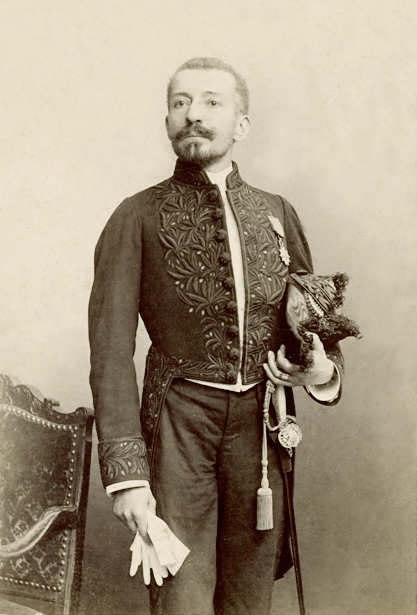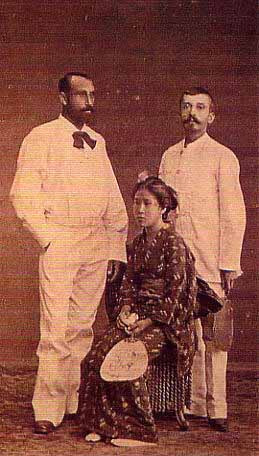

Partner Pierre le Cor
Queer Places:
141 Rue Pierre Loti, 17300 Rochefort, France
Rue des Pêcheurs, 64700 Hendaye, France
 Pierre
Loti (pseudonym of Louis Marie-Julien Viaud; 14 January 1850 – 10 June 1923)[1]
was a French naval officer and novelist, known for his exotic novels and short
stories.[2]
Pierre
Loti (pseudonym of Louis Marie-Julien Viaud; 14 January 1850 – 10 June 1923)[1]
was a French naval officer and novelist, known for his exotic novels and short
stories.[2]
Born to a Protestant family, Loti's education began in his birthplace, Rochefort, Charente-Maritime. At age 17 he entered the naval school in Brest and studied at Le Borda. He gradually rose in his profession, attaining the rank of captain in 1906. In January 1910 he went on the reserve list. He was in the habit of claiming that he never read books, saying to the Académie française on the day of his introduction (7 April 1892), "Loti ne sait pas lire" ("Loti doesn't know how to read"), but testimony from friends proves otherwise, as does his library, much of which is preserved in his house in Rochefort. In 1876 fellow naval officers persuaded him to turn into a novel passages in his diary dealing with some curious experiences at Constantinople. The result was the anonymously published Aziyadé (1879), part romance, part autobiography, like the work of his admirer, Marcel Proust, after him.
Loti proceeded to the South Seas as part of his naval training, living in Papeete, Tahiti for two months in 1872, where he "went native". Several years later he published the Polynesian idyll originally titled Rarahu (1880), which was reprinted as Le Mariage de Loti, the first book to introduce him to the wider public. His narrator explains that the name Loti was bestowed on him by the natives, after his mispronunciation of "roti" (a red flower). The book inspired the 1883 opera Lakmé by Léo Delibes. Loti Bain, a shallow pool at the base of the Fautaua Falls, is named for Loti.[3]
This was followed by Le Roman d'un spahi (1881), a record of the melancholy adventures of a soldier in Senegal. In 1882, Loti issued a collection of four shorter pieces, three stories and a travel piece, under the general title of Fleurs d'ennui (Flowers of Boredom).

In 1883 Loti achieved a wider public spotlight. First, he published the critically acclaimed Mon Frère Yves (My Brother Yves)), a novel describing the life of a French naval officer (Pierre Loti), and a Breton sailor (Yves Kermadec, inspired by Loti companion Pierre le Cor (1852-1927)), described by Edmund Gosse as "one of his most characteristic productions". Second, while serving in Tonkin (northern Vietnam) as a naval officer aboard the ironclad Atalante, Loti published three articles in the newspaper Le Figaro in September and October 1883 about atrocities that occurred during the Battle of Thuận An (20 August 1883), an attack by the French on the Vietnamese coastal defenses of Hue. He was threatened with suspension from the service for this indiscretion, thus gaining wider public notoriety. In 1884 his friend Émile Pouvillon dedicated his novel L'Innocent to Loti.
In 1886 Loti published a novel of life among the Breton fisherfolk, called Pêcheur d'Islande (An Iceland Fisherman), which Edmund Gosse characterized as "the most popular and finest of all his writings."[2] It shows Loti adapting some of the Impressionist techniques of contemporary painters, especially Monet, to prose, and is a classic of French literature. In 1887 he brought out a volume "of extraordinary merit, which has not received the attention it deserves", Propos d'exil, a series of short studies of exotic places, in his characteristic semi-autobiographic style. Madame Chrysanthème, a novel of Japanese manners that is a precursor to Madama Butterfly and Miss Saigon (a combination of narrative and travelog) was published the same year.[4]
In 1890 Loti published Au Maroc, the record of a journey to Fez in company with a French embassy, and Le Roman d'un enfant (The Story of a Child), a somewhat fictionalized recollection of Loti's childhood that would greatly influence Marcel Proust. A collection of "strangely confidential and sentimental reminiscences", called Le Livre de la pitié et de la mort (The Book of Pity and Death) was published in 1891.
Loti was aboard ship at the port of Algiers when news reached him of his election, on 21 May 1891, to the Académie française. In 1892 he published Fantôme d'orient, a short novel derived from a subsequent trip to Constantinople, less a continuation of Aziyadé than a commentary on it. He described a visit to the Holy Land in three volumes, The Desert, Jerusalem, and Galilee, (1895–1896), and wrote a novel, Ramuntcho (1897), a story of contraband runners in the Basque province, which is one of his best writings. In 1898 he collected his later essays as Figures et Choses qui passaient (Passing Figures and Things).
In 1899 and 1900 Loti visited British India, with the view of describing what he saw; the result appeared in 1903 in L'Inde (sans les anglais) (India (without the English)). During the autumn of 1900 he went to China as part of the international expedition sent to combat the Boxer Rebellion. He described what he saw there after the siege of Peking in Les Derniers Jours de Pékin (The Last Days of Peking, 1902).
Loti's later publications include: La Troisième jeunesse de Mme Prune (The Third Youth of Mrs. Plum, 1905), which resulted from a return visit to Japan and once again hovers between narrative and travelog; Les Désenchantées (The Unawakened, 1906); La Mort de Philae (The Death of Philae, 1908), recounting a trip to Egypt; Judith Renaudin (produced at the Théâtre Antoine, 1898), a five-act historical play that Loti presented as based on an episode in his family history; and, in collaboration with Emile Vedel, a translation of William Shakespeare's King Lear, produced at the Théâtre Antoine in 1904. Les Désenchantées, which concerned women of the Turkish harem, was based like many of Loti's books, on fact. It has, however, become clear that Loti was in fact the victim of a hoax by three prosperous Turkish women.[5]
In 1912 Loti mounted a production of The Daughter of Heaven, written several years earlier in collaboration with Judith Gautier for Sarah Bernhardt, at the Century Theatre in New York City.
He died in 1923 in Hendaye and was interred on the island of Oléron with a state funeral.
Loti was an inveterate collector and his marriage into wealth helped him support this habit. His house in Rochefort, a remarkable reworking of two adjacent bourgeois row houses, is preserved as a museum.[6] One elaborately tiled room is an Orientalist fantasia of a mosque, including a small fountain and five ceremoniously draped coffins containing desiccated bodies. Another room evokes a medieval banqueting hall. Loti's own bedroom is rather like a monk's cell, but mixes Christian and Muslim religious artifacts. The courtyard described in The Story of a Child, with the fountain built for him by his older brother, is still there.
My published books: